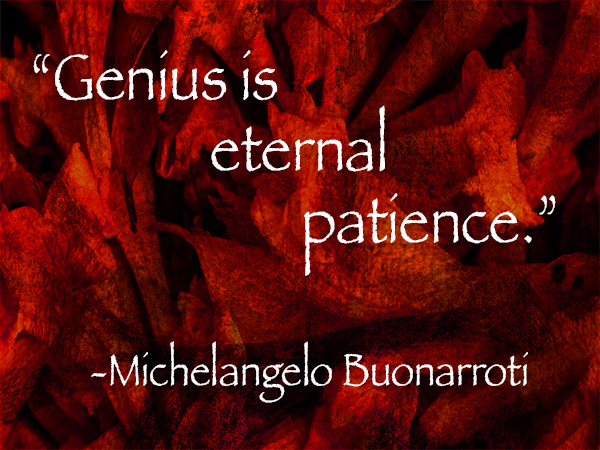Great works of Art.
What do most of them have in common? I posit that Michelangelo has it nailed.
“Genius is eternal patience.” Michelangelo Buonarroti
The patience and perseverance to complete the task would be very high on the list. Even works of art that were completed in a very short period of time had in their basis a long time learning and practicing the skills necessary to make that happen. Think of the great photographers and artists that come to mind immediately. All devoted their lives or a major portion of it to learning, practice, perfecting, practicing some more. It’s apparent in the depth of their work.
An artist goes through stages of learning. A child attempting art often starts with stick figures and very rudimentary shapes. As growth and practice occur perspective is added. Shadows create more dimension. Color begins to play a part with mixing, under-painting and differing colors laid side by side to give unusual effects. Final touches of opaque paint give the illusion of highlights and deeper shadows.
A musician starts with basic notes. Chopsticks on the piano. A slightly more advanced simple song. Then scales to train the brain and fingers in motor memory. Study. More in-depth practice until it’s possible to play notes at a speed and clarity for advanced intricate pieces.
Just as the other artists go through their paces as photographers we need to ‘learn the scales’ and add perspective and depth to our work as we advance our craft. There seems to be a tendency to think we are pretty good at making images before we even understand what makes a great image. I know I went through this at various stages of my photography career thinking I was pretty good at this or that. Now when I begin to think I am good at some area of my photography I go out and find those that really are and aspire to learn more.
We can take bits and pieces from other arts to make us better photographers.
As the musician practices scales to create motor memory we can sit with our cameras and make changes to settings without looking at the camera. Confirm it’s the setting we were trying for and repeat until all the controls become automatic.
Learning the vocabulary of our profession is important. You can’t create what you can’t think about or visualize in your brain and you can’t do that without knowing words for all kinds of light, shadow and form.
I guess the long story short is how much are you willing to work, to make mistakes, to study, to practice, to play in order to be able to create better images?
How much patience do you have??
Yours in Creative Photography, Bob
PS – Michelangelo made an appearance here last week in the Photo/Art Quote…. and that’s just coincidence.






